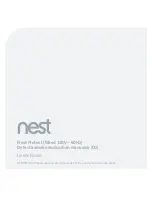
2 ft to 8 ft
61 cm to 2 m
15
14
WARNING
Before waving at Nest Protect to silence it,
identify the source of the danger and make
sure you’re safe.
WHICH ALERTS CAN BE SILENCED
>[WZi#KfWb[hjiYWdX[^ki^[ZXoki_d]
Nest Wave or the Nest button.
;c[h][dYoWbWhciYWddejX[^ki^[ZXoki_d]
Nest Wave or the Nest button if smoke reaches
a critical level.
8[YWki[j^[h[Wh[cWdoZ_\\[h[djjof[ie\
fires, you may experience an Emergency
Alarm without having first experienced a
Heads-Up alert. This means that dangerous
levels of smoke or CO occurred extremely
quickly and Nest Protect must sound the
Emergency Alarm.
7\j[hj^[D[ijFhej[Yji_doekh^ec[Wh[
connected to each other, whenever there’s a
Heads-Up or an Emergency Alarm in one room,
they will all tell you what and where the danger
is. So go to that room and wave at the Nest
Protect there to hush every Nest Protect in the
home. This will ensure that you will identify the
source of the danger in that room.
WARNING
J^[hWd][WdZfhef[hef[hWj_ede\Wdo
wireless device will vary depending on its
surroundings.
D[ijFhej[YjWbWhciWh[dejjeX[ki[Z
outdoors or to transmit between buildings.
The alarms will not communicate properly
in those conditions.
C[jWbeX`[YjiWdZc[jWbb_YmWbbfWf[hcWo
interfere with signals from wireless alarms.
Test your Nest Protects with metal doors
opened and closed.
PATHLIGHT
Usually Nest Protect has its light turned off,
but it will light your way as you walk underneath
it in the dark. You can enable or disable
Pathlight from the Nest Mobile app.
HEADS-UP AND EMERGENCY ALARMS
ALERTS
Nest Protect has two kinds of voice alerts:
Heads-Up and Emergency Alarms. A Heads-Up
is friendly warning before conditions get
dangerous. Nest Protect pulses yellow and
tells you where smoke or carbon monoxide is.
An Emergency Alarm occurs when smoke or
carbon monoxide reach dangerous levels.
Nest Protect pulses red, makes a loud alarm
sound and tells you what room the emergency
is in. The smoke alarm takes precedence when
carbon monoxide is also present.
NEST WAVE™
You can silence Heads-Up and most Emergency
Alarms by pushing the Nest button or by standing
under Nest Protect and waving your arm.
To use Nest Wave, move close to Nest Protect.
When it sees you, its light ring will glow a solid
color. Stay in that spot and wave your whole arm
until the alarm is hushed. Your hand should be
2 ft - 8 ft (60 cm to 2 m) away from Nest Protect.
Dense smoke will override Nest Wave and sound a
continuous alarm.
WIRELESS INTERCONNECT
Nest Protects connect wirelessly to each other
so that when one speaks, they all speak. That
means when one Nest Protect raises any kind
of alerts, every Nest Protect in the house will
tell you in which room the smoke or CO is in. For
example, if you’re in the bedroom and the alarm
goes off in the basement, the Nest Protect in
the bedroom will speak up and relay that alarm
so that you know where the danger is. To silence
the alert, go to that room and wave at the Nest
Protect there. That will hush every Nest Protect
in the house.
Nest Protect’s 120V connector does not have
a red/orange/yellow wire for interconnect as it
connects wirelessly. There’s no need to connect
any wire to the red/orange/yellow interconnect
wire from the ceiling/wall.
Nest Protects can typically communicate
with each other if they’re 50 ft (15m) apart
inside a home. Some features of a home may
reduce their range, including the number of
Óeehi"dkcX[h%i_p[e\heeci"\khd_jkh["jof[
of building material, suspended ceilings,
ductwork, large metallic appliances and
metal studs. This kind of interference can be
overcome by adding more Nest Protects that
can route wireless signals around obstructions.
Nest Protect - Battery (model number 05A) and
Nest Protect - Wired 120V (model number 05C) are
compatible and can be interconnected wirelessly.
Nest Protect wireless interconnect will not
work with other products from other brands.















